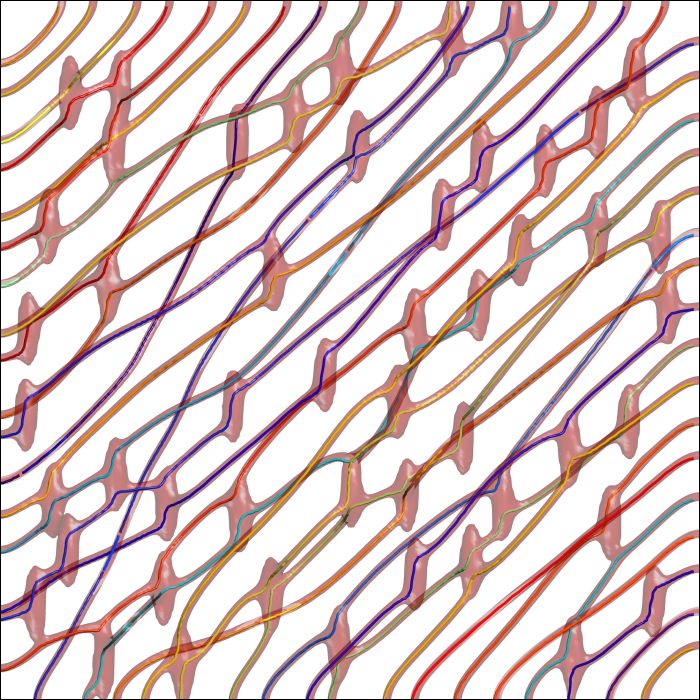As the U.S. power grid strains under growing demand from urban population centers, it’s become vital to efficiently transmit electricity from distant, often rural sources.
High-voltage, direct current, copper cables move more electricity with less waste heat than today’s alternating current system. But some power companies are experimenting with superconducting cables, with five times the electric current capacity of equal size copper cables. Superconducting cables could move power for pennies, but to be practical they must be more reliable and inexpensive.
Superconductivity emerges only under extreme cold and materials are finicky about maintaining their superconducting state in a magnetic field or an applied current that’s too strong. But the prospect of large-scale superconducting energy transport is real and drives Optimizing SuperConductor transport properties through large-scale simulation (OSCon), a partnership under the Department of Energy’s SciDAC-3 (Scientific Discovery through Advanced Computation) program. The OSCon team from Argonne National Laboratory’s Materials Science and Mathematics and Computer Science divisions collaborates with experimentalist colleagues to develop large-scale algorithms for superconductor optimization and other energy applications.
Ideally, electrons in a superconducting cable move without resistance among a matrix filled with miniature tornadoes spawned by magnetic fields. These vortices, a feature of all superconducting cables, can move laterally, limiting transport of electrical current to about 20 percent of the theoretical limit. Cable manufacturers add microscopic particles designed to hold, or pin, vortices within the cable, limiting their movement. Pinning vortices increases transmission, within limits, but there’s been little systematic research to find pinning agents’ ideal configurations and properties, says OSCon leader Andreas Glatz, a physicist interested in vortex dynamics.
The simulation found that at intermediate magnetic field strength, vortices were bent and ripped apart at pinning centers and traveled around in the superconductor.
Vortices created by the electromagnetic field experience the Lorentz force, which runs perpendicular to a current as it passes through a wire or cable. The vortices move through the system perpendicular to both the electrical current and the magnetic field.
By studying the behavior of vortices in materials power companies use and by experimenting with new materials and varying operating conditions, the research team hopes to provide a theoretical basis and predictive models to improve superconducting cable performance. To do that, the OSCon team has programmed innovative codes that simulate vortex dynamics within a superconducting medium under changing conditions, such as temperature, current and magnetic field strength.
Early numerical experiments on Mira, Argonne’s 10-petaflops IBM Blue Gene/Q system, allowed investigators to model conditions conducive to superconducting critical current – the maximum current that enables a material to maintain superconductivity. The team developed a technique to isolate and detect vortex lines in the complex large-scale data structure that represents the superconducting system. The method lets the researchers track vortices and visualize them in detail.
SciDAC partnership members used recent experimental data on irradiated superconducting cables to validate the codes. “Basically we rotate the magnetic field around the cable and, depending on the direction, we see how the critical current depends on the angle of the magnetic field,” Glatz says. “We calculated the critical current depending on the magnetic field and we found amazing agreement between simulation experiments and experimental results. This really shows that our codes can model realistic materials and catch the effect of pinning correctly.”
In another experiment, investigators applied a magnetic field parallel to the current. This creates an artificial condition because the magnetic field normally runs perpendicular to the current. Under these conditions, the normal Lorentz force no longer operates, setting up an interesting question of how the vortices will behave.
“You would expect that nothing is happening because the vortices cannot move with no force on them, and you would have a perfect superconductor,” Glatz says. “But this isn’t what’s happening. If you change the magnetic field in an applied current you see an increase in resistance. After a certain field threshold, the resistance goes away and superconducting properties return. Only at very large fields the superconductor breaks down again.”
The result puzzled everyone.
“This was a case where we could use our simulations to explain what was happening in the experiment,” Glatz says.
Because there was no Lorentz force to move the vortices, Glatz’ team reasoned that there must be some other mechanism to bend them, creating the observed resistance.
To test the effect, they set up a simulation with the same forces in place but added several pinning centers. The simulation found that at intermediate magnetic field strength, vortices were bent and ripped apart at pinning centers and traveled around in the superconductor in a helical motion. As the magnetic field strength increased beyond a certain threshold, the density of vortices also increased, forcing them to realign in parallel and reestablishing superconductivity.
“This is a good sign that we can use this information to build better superconducting cables,” Glatz says.
The newly developed code already has proved useful for other areas of physics, in particular atomic physics, where superfluids and Bose-Einstein condensates can be simulated using essentially the same code.
Glatz recently collaborated with University of Chicago physicists and published a paper in the Sept. 16 Physical Review Letters to overturn the idea that stable vortex rings or solitons exist within an ultracold atomic gas. Simulations of a superfluid showed that the only stable defects were vortex lines, which have dramatically different properties than vortex rings. Recent experiments confirmed the reinterpretation based on the simulations.
The OSCon team now develops methods and codes to improve critical currents by varying the size and shape of the pinning centers with advanced mathematical optimization methods. These will create predictions on how to build the best superconducting cables.
The team is tuning its code to make it applicable to almost any possible pinning agent, using supercomputers like Argonne’s Mira.
